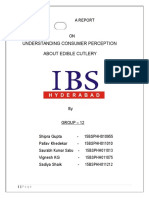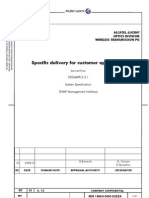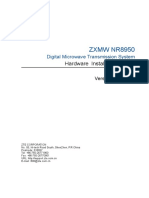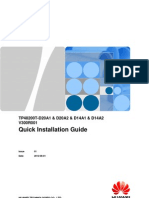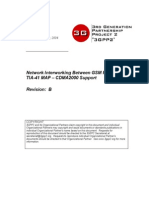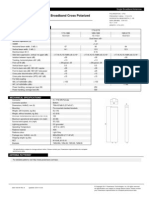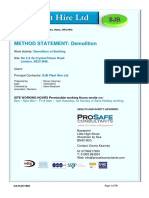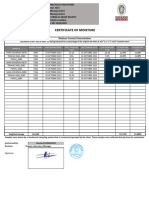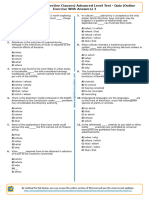ZTE ZXSDR R8882 Product Description
ZTE ZXSDR R8882 Product Description
Uploaded by
rdmiguel_19836Copyright:
Available Formats
ZTE ZXSDR R8882 Product Description
ZTE ZXSDR R8882 Product Description
Uploaded by
rdmiguel_19836Copyright
Available Formats
Share this document
Did you find this document useful?
Is this content inappropriate?
Copyright:
Available Formats
ZTE ZXSDR R8882 Product Description
ZTE ZXSDR R8882 Product Description
Uploaded by
rdmiguel_19836Copyright:
Available Formats
ZXSDR R8882 Product Description
UR12
Section 13.2.1.2
ZXSDR R8882 Product Description
ZTE Confidential Proprietary 1
ZXSDR R8882 Product Description
Version Date Author Reviewer Notes
V1.13 2013 ZTE
2014 ZTE Corporation. All rights reserved.
ZTE CONFIDENTIAL: This document contains proprietary information of ZTE and is not to be disclosed or used
without the prior written permission of ZTE.
Due to update and improvement of ZTE products and technologies, information in this document is subjected to
change without notice.
ZXSDR R8882 Product Description
2 ZTE Confidential Proprietary
TABLE OF CONTENTS
1 Overview ............................................................................................................ 4
1.1 Introduction .......................................................................................................... 4
1.2 Benefits ................................................................................................................ 4
1.3 Application Scenarios .......................................................................................... 5
2 Product Architecture ......................................................................................... 7
2.1 Physical Structure ................................................................................................ 7
2.2 Hardware Structure .............................................................................................. 9
2.2.1 Transceiver for multi modes (TRM) .................................................................... 10
2.2.2 Filter of dual duplexers (FLD) ............................................................................. 11
2.2.3 Power amplifier of dual channels (PAD) ............................................................. 11
2.2.4 EMC protection board (EPB) .............................................................................. 11
2.3 Software Architecture ......................................................................................... 12
2.4 Functionality ....................................................................................................... 13
3 Technical Specifications ................................................................................. 14
3.1 Physical Indices ................................................................................................. 14
3.2 Performance Indices .......................................................................................... 15
3.2.1 Operation Frequency Band ................................................................................ 15
3.2.2 Capacity ............................................................................................................. 15
3.2.3 Receiver Sensitivity ............................................................................................ 15
3.2.4 TOC Output Power ............................................................................................ 16
3.3 Power Indices .................................................................................................... 16
3.3.1 Power Supply ..................................................................................................... 16
3.3.2 Power Consumption ........................................................................................... 16
3.4 Transmission ..................................................................................................... 17
3.5 Working Environment ......................................................................................... 18
3.6 Electromagnetic Compatibility ............................................................................ 18
3.7 Reliability ........................................................................................................... 19
4 Installation ....................................................................................................... 19
5 Configurations ................................................................................................. 19
6 Abbreviation .................................................................................................... 21
ZXSDR R8882 Product Description
ZTE Confidential Proprietary 3
FIGURES
Figure 1-1 ZXSDR R8882 2T4R Application Scenario ........................................................ 6
Figure 1-2 ZXSDR R8882 2T2R Application Scenario ........................................................ 6
Figure 2-1 ZXSDR R8882 Physical Structure...................................................................... 7
Figure 2-2 ZXSDR R8882 External Interfaces..................................................................... 8
Figure 2-3 ZXSDR R8882 System Structure ......................................................................10
Figure 2-4 SDR BTS Software Structure ............................................................................12
TABLES
Table 2-1 ZXSDR R8882 External Interfaces Description ................................................... 8
Table 3-1 ZXSDR R8882 Physical Indices .........................................................................14
Table 3-2 ZXSDR R8882 Operation Frequency Band ........................................................15
Table 3-3 ZXSDR R8882 Capacity ....................................................................................15
Table 3-4 ZXSDR R8882 Receiver Sensitivity ...................................................................16
Table 3-5 ZXSDR R8882 TOC Output Power ....................................................................16
Table 3-7 ZXSDR R8882 Power supply indices .................................................................16
Table 3-8 ZXSDR R8882 Power Consumption in UMTS Single Mode ...............................16
Table 3-9 ZXSDR R8882 Power Consumption in GSM Single Mode .................................17
Table 3-10 ZXSDR R8882 Power Consumption in GSM/UMTS Dual-Mode ......................17
Table 3-11 ZXSDR R8882 CPRI Interfaces .......................................................................17
Table 3-12 ZXSDR R8882 Environment Condition Compatibility .......................................18
Table 3-13 ZXSDR R8882 Reliability Characteristics .........................................................19
Table 5-1 ZXSDR R8882 Configuration .............................................................................20
ZXSDR R8882 Product Description
4 ZTE Confidential Proprietary
1 Overview
1.1 Introduction
With the multi-mode era coming, ZTE, who is dedicated to providing comprehensive
network solutions and delivering the future-oriented quality network for the operators,
developed the ground breaking SDR unified platform with the essential feature to support
multi-mode and multi-band radio access.
Based on this innovative SDR platform, ZTE promotes a series of products to satisfy
different scenario requirements, including the Indoor macro, outdoor macro, distributed,
outdoor micro, mini and pico base station.
The SDR-based serial products aim to design a unified network which can bring
seamless experience to operators. In GSM, UMTS, LTE or mixed mode, it enables
operators to save CAPEX and OPEX significantly because they only need to deploy a
Uni-Radio Access Network (RAN), compared to the costs involved with independent
GSM and UMTS networks.
ZTE ZXSDR R8882 is one distributed Remote Radio Unit (RRU) used in ZTE Uni-RAN
total solution, with two transmitters. The RRU is based on the common ZTE new
generation RRU platform, and can work in GSM and UMTS single mode or multi-mode in
the same frequency band.
1.2 Benefits
Software Defined Radio (SDR) is the evolution of base station technology. ZTE has
made great effort and invested much in this new technology for many years. And then the
R8882 RRU product and B8200 BBU product based on SDR technology were released.
ZTEs SDR Uni-RAN architecture supports GSM, UMTS, LTE and Uni-RAN
simultaneously. Operators then can benefit a lot from ZTEs SDR platform. The following
part lists the key benefits for operators.
High performance
ZXSDR R8882 Product Description
ZTE Confidential Proprietary 5
To meet the growing demands for wide working bandwidth, R8882 modules with full
working bandwidth are released. Maximum working bandwidth of R8882 is 75MHz
for 1800M band and 35MHz for 900M band. For frequency spectrums become
scarce, resources allocated for operators tend to be characterized with
fragmentation and large span. RRUs with full working bandwidth integrate more
spectrum resources and help to decrease hardware investment exponentially.
Clearer and simpler network
R8882 supports GSM, UMTS, LTE or mixed technologies. Instead of running
hardware on independent platforms for each technology, operators can implement
various wireless technologies in software on the same hardware platform.
Since hardware platforms can be reused, there is significantly less investment risk
for deploying hardware. Wireless technologies are developing so fast, and investing
on one technology may bring risks to operators. SDR-based solutions will decrease
the investment risk since SDR platform can support various technologies.
Lower Total Cost of Ownership (TCO)
ZXSDR R8882s PA adopts advanced efficiency enhancement technologies to
realize high power efficiency, such as Doherty PA, DPD linear technology and
MCPA technology. Power consumption can be greatly decreased together with
these features.
Passive thermal dissipation design also contributes to power saving and less noisy.
The operation and maintenance of one single wireless network is much simpler
than multiple system networks. Fewer engineers are required and less
implementation to be taken for system interworking or upgrade.
1.3 Application Scenarios
ZXSDR R8882 is fully software defined. It supports GSM, UMTS, LTE single mode or
dual-mode through software update only. It supports multi-mode at the same frequency
band simultaneously. It fully satisfies operators requirements of hybrid network
deployment and long-term evolution at lower cost.
ZXSDR R8882 Product Description
6 ZTE Confidential Proprietary
Figure 1-1 & Figure 1-1 shows that the network can be easily expanded from S11 to S44,
or S111 to S444 with non-MIMO or 2*2 MIMO with least hardware changes.
Figure 1-1 ZXSDR R8882 2T4R Application Scenario
Figure 1-2 ZXSDR R8882 2T2R Application Scenario
ZXSDR R8882 Product Description
ZTE Confidential Proprietary 7
2 Product Architecture
2.1 Physical Structure
R8882 is the multi-carrier RF module with two transmitters. It has two PAs, with both PAs
working on 850M/900M/1800M/1900M/2100MHz/AWS. There are two types of R8882,
2T2R and 2T4R. The differences between 2T2R and 2T4R modules include working
bandwidth and number of receivers. In the physical appearance, R8882 2T4R has four
antenna feeder interfaces but R8882 2T2R only has two. Except this, there is no
difference in the shell.
Figure 2-1 ZXSDR R8882 Physical Structure
R8882 external interfaces are located at the bottom of R8882 and LMT at its side, as
shown in Figure 2-2.
ZXSDR R8882 Product Description
8 ZTE Confidential Proprietary
Figure 2-2 ZXSDR R8882 External Interfaces
The interfaces are described in the following table.
Table 2-1 ZXSDR R8882 External Interfaces Description
S.N. Label Interface Interface Type/Connector
1 PWR
-48V DC power input
interface
2-pin round metal connector (male)
2 MON
External monitoring
interface
8-pin straight panel mount round
socket (male)
3 AISG AISG interface 8-pin socket with a square base
4 GND PE interface 16 mm
2
yellow-green round terminal
5 OPT1
BBU and RRU
Interface/RRU
cascading interface
LC type optical interface (IEC 874)
6 OPT2
BBU and RRU
Interface/RRU
cascading interface
LC type optical interface (IEC 874)
ZXSDR R8882 Product Description
ZTE Confidential Proprietary 9
7
ANT4
(TX1/RX1)
Antenna feeder
interface
(Tx1/Rx1)
50 DIN-mode connector
8
ANT3
(RX3)
(Optional*)
Antenna feeder
interface (Rx3)
50 DIN-mode connector
9
ANT2
(RX2)
(Optional*)
Antenna feeder
interface (Rx2)
50 DIN-mode connector
10
ANT1
(TX0/RX0)
Antenna feeder
interface
(Tx0/Rx0)
50 DIN-mode connector
11 LMT
Ethernet interface
for operation and
maintenance
8P8C shielded right angle PCB
mount jack with LED (left yellow, right
green)
Optional*: For R8882 2T2R, ANT3 and ANT2 interfaces do not exist.
2.2 Hardware Structure
R8882 includes the following 4 main hardware modules:
Transceiver for multi modes (TRM)
Filter of dual duplexers (FLD)
Power amplifier of dual channels (PAD)
EMC protection board (EPB)
The hardware structure of R8882 is shown in Figure 2-3:
ZXSDR R8882 Product Description
10 ZTE Confidential Proprietary
Figure 2-3 ZXSDR R8882 System Structure
Optional: For R8882 2T2R, ANT3 and ANT2 interfaces do not exist.
2.2.1 Transceiver for multi modes (TRM)
The TRM has following functions:
Processes 4 (or 2) received signals and 2 transmitted signals
Communicates with baseband unit and cascading RRU
Captures reference clock signal from baseband unit
Supports downlink/uplink IQ signal processing
Supports radio frequency hopping function
Supports adaptive modulation rate processing
Provides indication light
Supports hardware failure self-detection and alarm
Provides communication interfaces, 2 CPRI interfaces
Supports reset function
ZXSDR R8882 Product Description
ZTE Confidential Proprietary 11
2.2.2 Filter of dual duplexers (FLD)
The FLD includes 2 duplexers and 4 (or 2) receiving filters and has the following
functions:
Transmits and receives uplink and downlink signals in duplex mode
Suppresses spurious emission on the downlink to get acceptable out-band T
spurious emission required by the system and related protocol
Suppresses interference signals on the uplink to achieve a satisfied noise
coefficient
2.2.3 Power amplifier of dual channels (PAD)
The PAD includes 2 PAs and 4 (or 2) LNAs and has following functions:
Amplifies downlink radio signals received from the TRM, and outputs the amplified
signals to the FLD
Amplifies four signals received from the FLD with the LNA, and then sends the
amplified signals to the TRM
Provides a pre-distortion feedback interface to the TRM
Provides an interface to the TRM for Voltage Standing Wave Ratio (VSWR)
detection (forward power detection)
Supports separate switch-off
Supports Inner-module temperature detection
Provides read and write interfaces for module inventory management
2.2.4 EMC protection board (EPB)
The EPB has following functions:
Provides the built-in lightning protection for -48 V power supply
ZXSDR R8882 Product Description
12 ZTE Confidential Proprietary
Provides -48 V power filter
Protects AISG signals (half-duplex 485 signal)
Provides two pairs of dry contacts
Protects the RS485 monitoring signals
Provides adaptation for external MON interface, AISG interface, and power
interface
Provides the hardware version identifiers of boards
2.3 Software Architecture
The software system of R8882 can be divided into operating support layer and
application layer.
Figure 2-4 SDR BTS Software Structure
The operating support layer provides the functions of OSS, while OAM, DBS, BRS,
BRACS and SCS serve different BTS modes.
GSM/UMTS/LTE Functions
NOP
OMC-B
SCS
OAM DBS BRACS BRS
Hardware (BSP)
Linux
LMT
OSS
ZXSDR R8882 Product Description
ZTE Confidential Proprietary 13
OAM (Operating and Maintenance) is to provide the configuration, alarm and
performance measurement function.
DBS (Database Sub-system) is the database system.
BRS (Bearer Sub-system) is for protocol stack processing.
BRACS (Bearer Access Control Sub-system) is to control the access to bear layer.
SCS (System Control Sub-system) is to control the power supplying and
active/standby switching.
OSS (Operation Support Sub-system) is the support layer in this entire framework, which
is a hardware platform for running software and provides basic functions like scheduling,
timer, memory management, communication, sequencing control, monitoring, alarming
and logging.
Board Support Package (BSP) is the software closely connected with the board
hardware and supports Real Time Operation Support Sub-system (RT OSS) to work on
the board.
2.4 Functionality
R8882 supports the following functionalities:
Supports 850M/900M/1800M/1900M/2100MHz/AWS bands
Supports 80W of output power
supports two cells configuration with 2T4R module
Supports 2*2 MIMO configuration
Supports GSM only, UMTS only, LTE only or mixed mode module
Supports maximally 35MHz working bandwidth in 900MHz, 75MHz in 1800MHz,
and full working bandwidth in 850M/1900M/2100MHz/AWS bands
ZXSDR R8882 Product Description
14 ZTE Confidential Proprietary
Supports maximally 6 GSM TRXs in GSM single mode, 4 UMTS carriers in UMTS
single mode or 20MHz for LTE in one PA
Supports RTWP report interval at 100ms and 2ms
Supports transmit power reporting function for every carrier
Supports over loading protection function for power amplifier
Supports measurement, compensation and adjustment function for channel delay
Supports dynamic PA voltage adjustment to achieve best efficiency in different
system loads
Supports transmitting channel switching on/off function
Supports built-in lightning protection function for DC power supply
3 Technical Specifications
3.1 Physical Indices
ZXSDR R8882 employs the compact design, whose physical indices are listed below.
Table 3-1 ZXSDR R8882 Physical Indices
Item Index
Dimension (H*W*D) 480*320*150 mm (23L)
Weight 23 Kg
Color Silver gray
ZXSDR R8882 Product Description
ZTE Confidential Proprietary 15
3.2 Performance Indices
3.2.1 Operation Frequency Band
Table 3-2 ZXSDR R8882 Operation Frequency Band
Item Index
Operation frequency band
GSM single mode: 850M/900M/1.8G/1.9GHz
UMTS single mode:
850M/900M/1.9G/2.1GHz/AWS
LTE single mode:
850M/900M/1.8G/1.9G/2.1GHz/AWS
G/U dual-mode: 850M/900M/1.9GHz
G/L dual-mode: 900M/1.8GHz
U/L dual-mode: 900M/2.1GHz
* R8882 2T2R is for 1800MHz only, and R8882 2T4R for all bands mentioned above.
3.2.2 Capacity
Table 3-3 ZXSDR R8882 Capacity
Item Index
Capacity
GSM: 12 TRXs, or 6 TRXs@900M + 6
TRXs@1800M
UMTS: 8 Carriers
LTE: 1.4M, 3M, 5M, 10M, 15M, 20MHz
G/U 900M: 8 GSM TRXs + 2 UMTS Carriers or
4 GSM TRXs + 4 UMTS Carriers
G/L 900M: 4 GSM TRXs + 20M LTE
G/L 1.8G: 8 GSM TRXs + 20M LTE
U/L dual-mode: 2 UMTS carriers + 20M LTE
3.2.3 Receiver Sensitivity
Receiver sensitivity of R8882 is shown as following table:
ZXSDR R8882 Product Description
16 ZTE Confidential Proprietary
Table 3-4 ZXSDR R8882 Receiver Sensitivity
Item Index
Receiver sensitivity
-113.5 dBm @ GSM single antenna
-126.5 dBm @ UMTS single antenna
-129.2 dBm @ UMTS dual antennas
-106dBm @ LTE single antenna
-108.6dBm @ LTE double antennas
3.2.4 TOC Output Power
Table 3-5 ZXSDR R8882 TOC Output Power
Item Index
GSM 2*60W (GMSK) / 2*40W (8PSK)
UMTS/LTE single mode, or
Dual-mode
2*60W
3.3 Power Indices
3.3.1 Power Supply
Table 3-6 ZXSDR R8882 Power supply indices
Modules Input Power
R8882
DC: -48 V (-37 V-60 V DC)
AC: 110 V/220 V (90 V290 V AC) (by AC/DC
lightning protection unit)
3.3.2 Power Consumption
Table 3-7 ZXSDR R8882 Power Consumption in UMTS Single Mode
Items
(S1/1, 2PA, TOC 2*20W)
Power Consumption (W)
Average Peak
ZXSDR R8882 Product Description
ZTE Confidential Proprietary 17
Items
(S1/1, 2PA, TOC 2*20W)
Power Consumption (W)
Average Peak
R8882 (900MHz) 185 240
R8882 (2.1GHz) 155 210
R8882 (850MHz) 145 195
R8882 (1900MHz) 210 275
Table 3-8 ZXSDR R8882 Power Consumption in GSM Single Mode
Items
(S4/4, 2PA, TOC 2*60W)
Power Consumption (W)
Average Peak
R8882 (900MHz) 290 445
R8882 (1800MHz) 280 455
R8882 (850MHz) 240 395
R8882 (1900MHz) 320 515
Table 3-9 ZXSDR R8882 Power Consumption in GSM/UMTS Dual-Mode
Items
(8G2U, 2PA, TOC 2*(4*10W
GSM+20W UMTS)
Power Consumption (W)
Average Peak
R8882 (900MHz) 300 445
R8882 (850MHz 250 395
R8882 (1900MHz) 335 515
3.4 Transmission
ZXSDR R8882 is connected to BBU through CPRI interfaces.
Table 3-10 ZXSDR R8882 CPRI Interfaces
Item Value Interface Kind Speed Standard
ZXSDR R8882 Product Description
18 ZTE Confidential Proprietary
CPRI interface 2 SFP (LC)
1.25Gbps
2.5Gbps
3Gbps
CPRI V4.2
3.5 Working Environment
Table 3-11 ZXSDR R8882 Environment Condition Compatibility
Item Index
Temperature -40 - +55 C
Relative humidity 10% - 100%
Waterproof/dustproof IP65
Ground
5 ; earth resistance can be less than 10 in
thunder-less area where there less than 20
thunderstorm days per year.
Storage
Indoor pack deposited
Temperature: -40 C to 70 C
Relative Humidity: 5% to 100%
3.6 Electromagnetic Compatibility
YD/T 1595.2-2007
ETSI EN 301 489-01, ETSI EN 301 489-23
ETSI EN 300 386V1.3.2
(CISPR22) Class B
Directive 1999/5/EC (R&TTE)
ZXSDR R8882 Product Description
ZTE Confidential Proprietary 19
3.7 Reliability
In R8882, the algorithm of system reliability conforms to the national military GJB/Z299B
Electronic Equipment Reliability Estimation Manual and US military handbook
MIL-HDBK-217F Electronic Equipment Reliability Estimation.
Table 3-12 ZXSDR R8882 Reliability Characteristics
Item Index
MTBF 322000 hours
MTTR 1 hour
Availability index 99.999689%
Down duration 1.632min/year
4 Installation
ZXSDR R8882 is easy to be deployed.
It is portable for transportation and flexible installation on the pole, tower and
against wall.
Only fibers, power cables, RF cable antennas, PE and AISG cables need to be
connected.
It is suitable for any weather condition with IP65 water resistance and dust proof
case.
5 Configurations
ZXSDR R8882 can be configured as GSM, UMTS, LTE single mode or mixed mode
through software. By choosing different frequencies and software configurations, R8882
can support various GSM/UMTS/LTE configurations. Both R8882 2T4R and 2T2R
modules support 2*2 MIMO, and R8882 2T4R supports two cells with 1T2R for each cell.
ZXSDR R8882 Product Description
20 ZTE Confidential Proprietary
Table 5-1 ZXSDR R8882 Configuration
Site Type R8882 Qty
GSM S6/6/6
2
UMTS S2/2/2
GSM S8/8/8
3
UMTS S2/2/2 2*2 MIMO
GSM S4/4/4+UMTS S1/1/1
GSM S8/8/8+UMTS S1/1/1
GSM S4/4/4+LTE 20M
UMTS S2/2/2+LTE 20M
ZXSDR R8882 Product Description
ZTE Confidential Proprietary 21
6 Abbreviation
Abbreviation Full Characters
3GPP 3
rd
Generation Partnership Project
BBU Base Band processing Unit
BRACS Barrier Access Control Sub-system
BRS Barrier Sub-system
BSP Board Support Package
CAPEX Capital Expenditure
CPRI Common Public Radio Interface
DBS Data Base Sub-system
GSM Global System for Mobile communications
IBW Instantaneous Bandwidth
LMT Local Maintenance Terminal
MIMO Multi Input Multi Output
MTBF Mean Time Between Failures
MTTR Mean Time To Recovery
OAM Operating And Maintenance
OPEX Operation Expenditure
OSS Operation Support Sub-system
RF Radio Frequency
RRU Remote Radio Unit
RTWP Received Total Wideband Power
SCS System Control Sub-system
SDR Software Defined Radio
UE User Equipment
UMTS Universal Mobile Telecommunications System
You might also like
- Rru RF Report - I22w00035-Tdru518Document253 pagesRru RF Report - I22w00035-Tdru518Délsio CabáNo ratings yet
- Market Research On Edible CutleryDocument20 pagesMarket Research On Edible CutleryVignesh Kg100% (5)
- Putian Antenna SpecificationDocument109 pagesPutian Antenna SpecificationMukesh Jung Thapa100% (1)
- Trcu TM10P1V01Document1 pageTrcu TM10P1V01Al LaNo ratings yet
- MPR-E R2 1 SNMPSysSpec - Wind Profiled - It10Document61 pagesMPR-E R2 1 SNMPSysSpec - Wind Profiled - It10Tap Zoo CatelloNo ratings yet
- Group 2 4620 Group ReportDocument15 pagesGroup 2 4620 Group ReportAtitat Rattanachata100% (1)
- Cqi 11Document73 pagesCqi 11dwimukh360No ratings yet
- ZXSDR R8882 Product DescriptionDocument24 pagesZXSDR R8882 Product DescriptionJumongNo ratings yet
- R8854S2600.User Manual Part 3 3787010Document22 pagesR8854S2600.User Manual Part 3 3787010Ivan StevkovskiNo ratings yet
- 9.ZXSDR R8882 L200 Hardware Structure-32Document32 pages9.ZXSDR R8882 L200 Hardware Structure-32mehdi_mehdiNo ratings yet
- ZXSDR A8612 (V1.0) Hardware InstallationDocument69 pagesZXSDR A8612 (V1.0) Hardware InstallationАртём ДицNo ratings yet
- Evolution Series EDGE Technical Description Rev C - LetterDocument43 pagesEvolution Series EDGE Technical Description Rev C - LetterErivelton SouzaNo ratings yet
- SJ 20101028153047 005 ZXSDR 20R8882 20GUL1812 V2.00 Remote 20radio 20unit 20hardware 20description - 435192Document19 pagesSJ 20101028153047 005 ZXSDR 20R8882 20GUL1812 V2.00 Remote 20radio 20unit 20hardware 20description - 435192glocallNo ratings yet
- SJ-20151105160201-004-ZXMW NR8950 (V2.04.02) Hardware Installation GuideDocument95 pagesSJ-20151105160201-004-ZXMW NR8950 (V2.04.02) Hardware Installation GuideRizki Syam Nugroho100% (1)
- SJ-20121119144002-004-ZXSDR BS8912 U2100 (HV1.0) Hardware Installation PDFDocument51 pagesSJ-20121119144002-004-ZXSDR BS8912 U2100 (HV1.0) Hardware Installation PDFSoar ReyNo ratings yet
- SJ 20130319141920 002 ZXMW nr8120 v20301 System Descriptionpdf PDFDocument80 pagesSJ 20130319141920 002 ZXMW nr8120 v20301 System Descriptionpdf PDFjose damianNo ratings yet
- Dual-End FastConnect Distribution Cable Datasheet 01Document4 pagesDual-End FastConnect Distribution Cable Datasheet 01Samuel NesibuNo ratings yet
- RRU3668 Hardware Description (05) (PDF) - en PDFDocument42 pagesRRU3668 Hardware Description (05) (PDF) - en PDFJaime Yarihuaman QuispeNo ratings yet
- Alcatel-Lucent 9412 eNodeB CompactDocument2 pagesAlcatel-Lucent 9412 eNodeB Compactomauriciogal100% (2)
- WMPT For Transmission For NodeBDocument5 pagesWMPT For Transmission For NodeBSantiago CoderlioNo ratings yet
- Introduction To ZXSDR Products (GSM)Document68 pagesIntroduction To ZXSDR Products (GSM)golak9107100% (7)
- RRU5502 DescriptionDocument40 pagesRRU5502 DescriptionMauricioNo ratings yet
- FTIF Transport PDH / Ethernet: Support of TDM Interfaces and Extended Ethernet ConnectivityDocument1 pageFTIF Transport PDH / Ethernet: Support of TDM Interfaces and Extended Ethernet ConnectivityReza BordbarNo ratings yet
- RTN 905 DetailsDocument11 pagesRTN 905 DetailsMuhammad SalahuddinNo ratings yet
- Huong Dan Cai Dat (OMT) CombaDocument12 pagesHuong Dan Cai Dat (OMT) Combahutech2000No ratings yet
- SJ-20110303201652-001-ZXA10 F600G (V1.0) Optical Network Terminal User ManualDocument24 pagesSJ-20110303201652-001-ZXA10 F600G (V1.0) Optical Network Terminal User ManualJoan GeneNo ratings yet
- G LI 002 BTS3006C Hardware Structure 20070403 A 1.0Document72 pagesG LI 002 BTS3006C Hardware Structure 20070403 A 1.0naveedalishaNo ratings yet
- SJ-20141110151550-014-ZXSDR UniRAN TDD-LTE (V3.20.50) Dynamic Data Management Operation GuideDocument59 pagesSJ-20141110151550-014-ZXSDR UniRAN TDD-LTE (V3.20.50) Dynamic Data Management Operation GuidetestNo ratings yet
- Portable Control Adapter: ManualDocument64 pagesPortable Control Adapter: ManualfbsnakeNo ratings yet
- ZXMW SR10 S340 (V2.0) Software Upgrade GuideDocument44 pagesZXMW SR10 S340 (V2.0) Software Upgrade GuidePatel VaibhavNo ratings yet
- Harris MicrostarDocument2 pagesHarris MicrostarLuis HuamanNo ratings yet
- BBU DesignDocument19 pagesBBU DesignTarek El DeghedyNo ratings yet
- Actix Software Installation GuideDocument34 pagesActix Software Installation GuideCuongDolaNo ratings yet
- TP48200T-D20A1 & D20A2 & D14A1 & D14A2 Quick Installation Guide (V300R001 - 01)Document56 pagesTP48200T-D20A1 & D20A2 & D14A1 & D14A2 Quick Installation Guide (V300R001 - 01)Victor Alejandro Matamoros AlcainoNo ratings yet
- BD3 6KTL RL1 User Manual V1.4Document42 pagesBD3 6KTL RL1 User Manual V1.4Cristian-Valentin RaduNo ratings yet
- Zte GuideDocument28 pagesZte GuideJason MendozaNo ratings yet
- UMTS Time Slots, Channel CodingDocument9 pagesUMTS Time Slots, Channel CodingAntariksha SinghNo ratings yet
- ZXWR RNC Product DescriptionDocument23 pagesZXWR RNC Product DescriptionMaxime de SouzaNo ratings yet
- DRU900Document4 pagesDRU900Earl LumNo ratings yet
- Manual Do ProdutoDocument71 pagesManual Do ProdutocarlosNo ratings yet
- Node B Commissionig Document PDFDocument338 pagesNode B Commissionig Document PDFPrince Kelly100% (1)
- NetEngine 8000 F2A-8K36H DatasheetDocument8 pagesNetEngine 8000 F2A-8K36H DatasheetShahed IsrarNo ratings yet
- Guidelines & Specifications - Civil & Tower Works PDFDocument32 pagesGuidelines & Specifications - Civil & Tower Works PDFHeaven's Prince0% (1)
- ZTE NR9150 Product DescriptionDocument187 pagesZTE NR9150 Product DescriptionRustam EfendiNo ratings yet
- OWE020101 (Slide) WASN9770 V200R001 Product Description 200803 B V1.1Document31 pagesOWE020101 (Slide) WASN9770 V200R001 Product Description 200803 B V1.1Faisal AyubNo ratings yet
- NetEngine 8000 M14, M8 and M4 V800R023C00SPC500 Configuration Guide 04 Interface and Data LinkDocument207 pagesNetEngine 8000 M14, M8 and M4 V800R023C00SPC500 Configuration Guide 04 Interface and Data LinkHebertNo ratings yet
- ZTE NR9120 Product DescriptionDocument153 pagesZTE NR9120 Product DescriptionRustam EfendiNo ratings yet
- WNG012 L2100 NC DN CJ Slogohimo 56a0ecj 113623590Document46 pagesWNG012 L2100 NC DN CJ Slogohimo 56a0ecj 113623590Roni AndikaNo ratings yet
- Exam ZTEDocument3 pagesExam ZTESloan Ian AriffNo ratings yet
- Keygen Dan Serial Number Seluruh ProductDocument13 pagesKeygen Dan Serial Number Seluruh ProductRhegindNo ratings yet
- Trouble Shooting - Case AnalysisDocument26 pagesTrouble Shooting - Case AnalysisRamiz RzaogluNo ratings yet
- RRU3232 Hardware Description (01) (PDF) - enDocument30 pagesRRU3232 Hardware Description (01) (PDF) - enmohye1230% (1)
- R8882 Correct 8882Document113 pagesR8882 Correct 8882MoketeNo ratings yet
- Study On UMTSLTE in 900 MHZ Band and Coexistence With 850 MHZ BandDocument34 pagesStudy On UMTSLTE in 900 MHZ Band and Coexistence With 850 MHZ BandMuhammad Jamil AwanNo ratings yet
- Network Inter Working Between GSM MAP and ANSI-41 CDMADocument547 pagesNetwork Inter Working Between GSM MAP and ANSI-41 CDMAapi-3815142100% (1)
- Fibeair® Ip-20 Ceraos Version 8.2: User Guide For Fibeair Ip-20G and Ip-20GxDocument856 pagesFibeair® Ip-20 Ceraos Version 8.2: User Guide For Fibeair Ip-20G and Ip-20GxNana SuhernaNo ratings yet
- ZTE EquipmentDocument3 pagesZTE EquipmentsamirhammoudNo ratings yet
- RTN 620 Product Description (V100R003 - 07)Document122 pagesRTN 620 Product Description (V100R003 - 07)Jonathan Domingo100% (8)
- VoIP and Unified Communications: Internet Telephony and the Future Voice NetworkFrom EverandVoIP and Unified Communications: Internet Telephony and the Future Voice NetworkNo ratings yet
- 04 Gul Der ZXSDR r8882 Product Description Uniran15 v1.00Document24 pages04 Gul Der ZXSDR r8882 Product Description Uniran15 v1.00GiuseppeNapolitanoNo ratings yet
- UL - DER - ZXSDR R8402 Product Description - UniRAN15 - V1.10 - 20160516Document19 pagesUL - DER - ZXSDR R8402 Product Description - UniRAN15 - V1.10 - 20160516noumizredhaNo ratings yet
- Configuring Bing Maps For Enterprise V8Document6 pagesConfiguring Bing Maps For Enterprise V8rdmiguel_19836No ratings yet
- ALU BSC-TC Alarm DictionaryDocument533 pagesALU BSC-TC Alarm Dictionaryrdmiguel_19836No ratings yet
- Huawei RNC Parameter ReferenceDocument1,783 pagesHuawei RNC Parameter Referencerdmiguel_19836100% (2)
- ILSA User Reference GuideDocument48 pagesILSA User Reference Guiderdmiguel_19836No ratings yet
- UMTS Radio Network PlanningDocument32 pagesUMTS Radio Network Planningxossog100% (8)
- 7720.00 Datasheet - 2500158Document1 page7720.00 Datasheet - 2500158Arief Agung Pribowo MNo ratings yet
- UMTS Radio Network PlanningDocument32 pagesUMTS Radio Network Planningxossog100% (8)
- Food ReviewDocument4 pagesFood ReviewRonaldo AstilleroNo ratings yet
- Alloy 20Document2 pagesAlloy 20bagulrahul2023No ratings yet
- Reported By: Sr. Jinggle U. Emata John Erick S Enero Calamba Doctors' CollegeDocument35 pagesReported By: Sr. Jinggle U. Emata John Erick S Enero Calamba Doctors' CollegeMarivic DianoNo ratings yet
- The Wuhan Lab at The Heart of The 'Extremely Unlikely' Leak TheoryDocument3 pagesThe Wuhan Lab at The Heart of The 'Extremely Unlikely' Leak TheoryAdriano Franco RoqueNo ratings yet
- Unhappy IndiaDocument610 pagesUnhappy IndiacuteNo ratings yet
- Ro-Buh-Qpl: Express WorldwideDocument3 pagesRo-Buh-Qpl: Express WorldwideverschelderNo ratings yet
- Cloud Security Quiz Answers NSE 2 Information Security Awareness FortinetDocument2 pagesCloud Security Quiz Answers NSE 2 Information Security Awareness Fortinetlakis lalakis888No ratings yet
- METHOD STATEMENT: Demolition: Work Activity SiteDocument50 pagesMETHOD STATEMENT: Demolition: Work Activity SiteHeba S. Al-saudiNo ratings yet
- Practice Test IDocument15 pagesPractice Test ISasha KozmonautNo ratings yet
- Avoid Making Losses in Stock MarketDocument1 pageAvoid Making Losses in Stock MarketPrajata DasChowdhuryNo ratings yet
- OGV082 MV GENIUSHIP Moisture Reportps84Document1 pageOGV082 MV GENIUSHIP Moisture Reportps84masterablhawkNo ratings yet
- Psychology Case Study On Emotional IntelligenceDocument9 pagesPsychology Case Study On Emotional IntelligenceSophiya PrabinNo ratings yet
- Lecture 7, 8: by Hannan Bin Liaqat Department of Information Technology University of GujratDocument24 pagesLecture 7, 8: by Hannan Bin Liaqat Department of Information Technology University of GujratAbdullah AbbasNo ratings yet
- PWC Tax Transparency Compliance and Exchange of InformationDocument2 pagesPWC Tax Transparency Compliance and Exchange of InformationInu RukawaNo ratings yet
- AIS 2036 Lecture 1Document30 pagesAIS 2036 Lecture 1Cindy ChanNo ratings yet
- Volvo FM Service Manual - Lubrication Service and Oil ChangesDocument47 pagesVolvo FM Service Manual - Lubrication Service and Oil ChangesDawit AssfawNo ratings yet
- Mid Term Exam - FE 63 240226Document3 pagesMid Term Exam - FE 63 240226Mai AnhNo ratings yet
- Machine Lecture 01Document52 pagesMachine Lecture 01abdulsalamabdulkadir55919No ratings yet
- Digital Booklet - Mamma Mia!Document7 pagesDigital Booklet - Mamma Mia!Alessandro SorzeNo ratings yet
- Unit 4Document12 pagesUnit 4Eusivia PasiNo ratings yet
- Classification of Composite MaterialsDocument4 pagesClassification of Composite Materialsthasarathanr1993_939No ratings yet
- Download Innovative Houses Concepts for Sustainable Living 1st Edition Avi Friedman ebook All Chapters PDFDocument50 pagesDownload Innovative Houses Concepts for Sustainable Living 1st Edition Avi Friedman ebook All Chapters PDFpyrahgroppg7100% (4)
- Wipo Smes Sha 04 7Document45 pagesWipo Smes Sha 04 7Taslima AkterNo ratings yet
- NCM101 Lesson Guide 6Document11 pagesNCM101 Lesson Guide 6Yahra DatangNo ratings yet
- 345 - Relative Clauses Adjective Clauses Advanced Level Test Quiz Online Exercise With Answers 3Document4 pages345 - Relative Clauses Adjective Clauses Advanced Level Test Quiz Online Exercise With Answers 3uyenha.ulisNo ratings yet
- 3F Filippi General Catalogue Led 2020.3-EN PDFDocument624 pages3F Filippi General Catalogue Led 2020.3-EN PDFMircea MiNo ratings yet
- Fixed Free Fixed Free Plate Natural Frequency AnalysisDocument7 pagesFixed Free Fixed Free Plate Natural Frequency AnalysisJan ScarNo ratings yet

